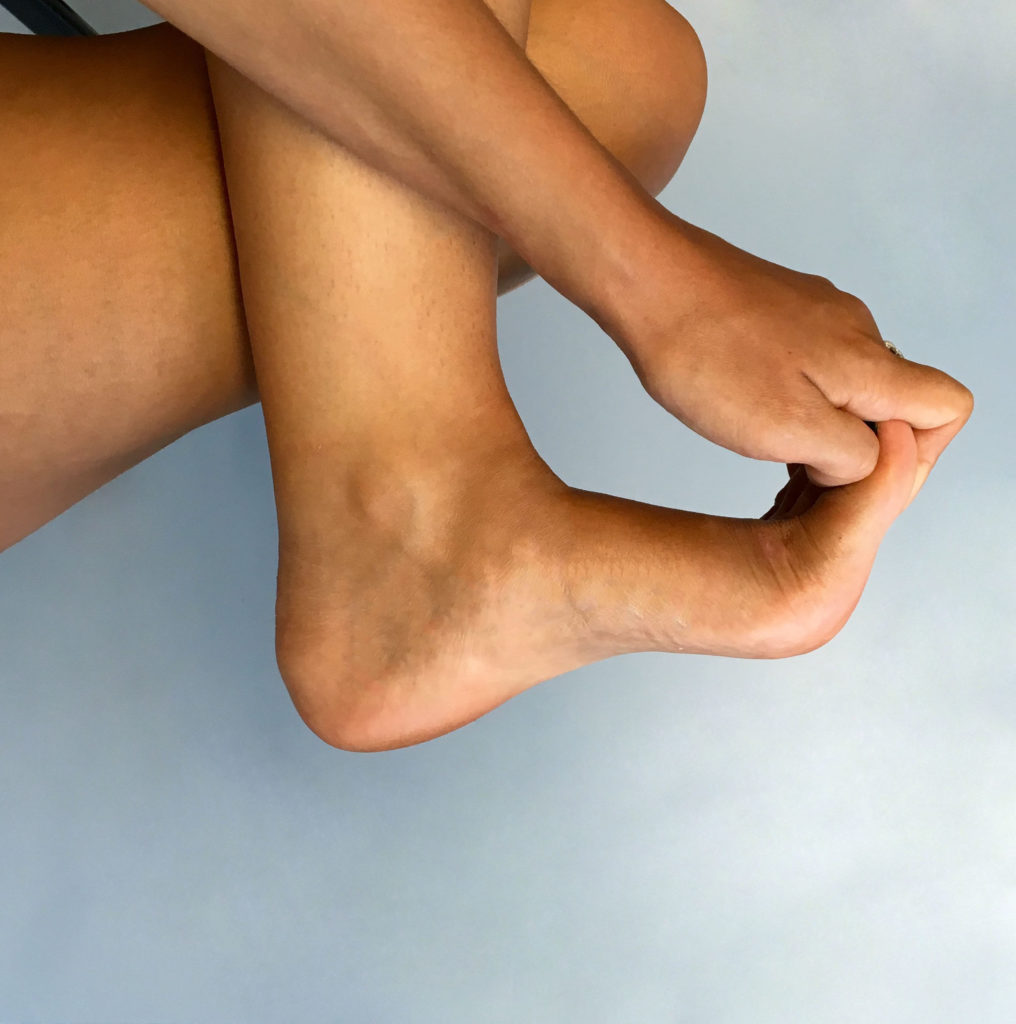Stretching
There are two stretches that can help to reduce plantar heel pain, calf stretches and plantar fascia stretches. These stretches can be effective at reducing plantar heel pain, and you should consider them as part of the ‘core’ treatment.
-

Plantar fascia stretches
To perform the stretches, cross your leg over your knee, and pull back your toes and your ankle. It is important to remember to perform the stretches before you stand up in the morning, or at any time after you stand after a period of rest. In total, we recommend that you peform the exercise 5 times a day.
Try to hold each stretch for 10 seconds, then repeat this 10 times. Overall, this stretch will take 110 seconds to complete.
Please view the video for a demonstration.
-

Calf stretches
A decrease in the range of motion of the ankle is a risk factor for plantar heel pain. Tight calf muscles is one reason why you may experience decreased ankle joint range of motion. Improving the flexibility of the calf muscle can be a good way to increase ankle joint range of motion, and reduce plantar heel pain.
To perform the stretches, place one foot behind you and lean into the wall. You should feel a stretch in your calf muscle. It is important to remember to keep your heel on the ground and your back knee straight. Try to hold each stretch for 10 seconds, and repeat it 3 times. Do this for both legs and repeat it 5 times a day.
Please view the video for a demonstration.
Safety
Both stretches are very safe, and it is unlikely that you will have any side effects.
Evidence summary
There is evidence to support stretching as an effective treatment. Currently, evidence exists to suggest that:
- stretching is similar to control
- foot taping is more effective than stretching
- plantar fascia stretching is better than calf stretching
- plantar fascia stretching is just as effective as shockwave therapy. However, the combination of plantar fascia stretching and shockwave is better than shockwave alone
Links to research
1. Radford JA, Landorf KB, Buchbinder R, Cook C. Effectiveness of calf muscle stretching for the short-term treatment of plantar heel pain: a randomised trial. BMC Musculoskelet Disord. 2007;8: 36. doi: 10.1186/1471-2474-8-36
2. Hyland MR, Webber-Gaffney A, Cohen L, Lichtman SW. Randomized controlled trial of calcaneal taping, sham taping, and plantar fascia stretching for the short-term management of plantar heel pain. J Orthop Sport Phys Ther. 2006;36: 364–371. doi: 10.2519/jospt.2006.2078
3. DiGiovanni BF, Nawoczenski DA, Lintal ME, Moore EA, Murray JC, Wilding GE, et al. Tissue-specific plantar fascia-stretching exercise enhances outcomes in patients with chronic heel pain: a prospective, randomized study. J Bone Joint Surg Am. 2003;85A: 1270–1277. Link
4. Rompe JD, Cacchio A, Weil Jr. L, Furia JP, Haist J, Reiners V, et al. Plantar fascia-specific stretching versus radial shock-wave therapy as initial treatment of plantar fasciopathy. J Bone Joint Surg Am. 2010;92: 2514–2522. doi: 10.2106/JBJS.I.01651
5. Rompe JD, Furia J, Cacchio A, Schmitz C, Maffulli N. Radial shock wave treatment alone is less efficient than radial shock wave treatment combined with tissue-specific plantar fascia-stretching in patients with chronic plantar heel pain. Int J Surg. 2015/05/06. 2015;24: 135–142. doi: 10.1016/j.ijsu.2015.04.082
